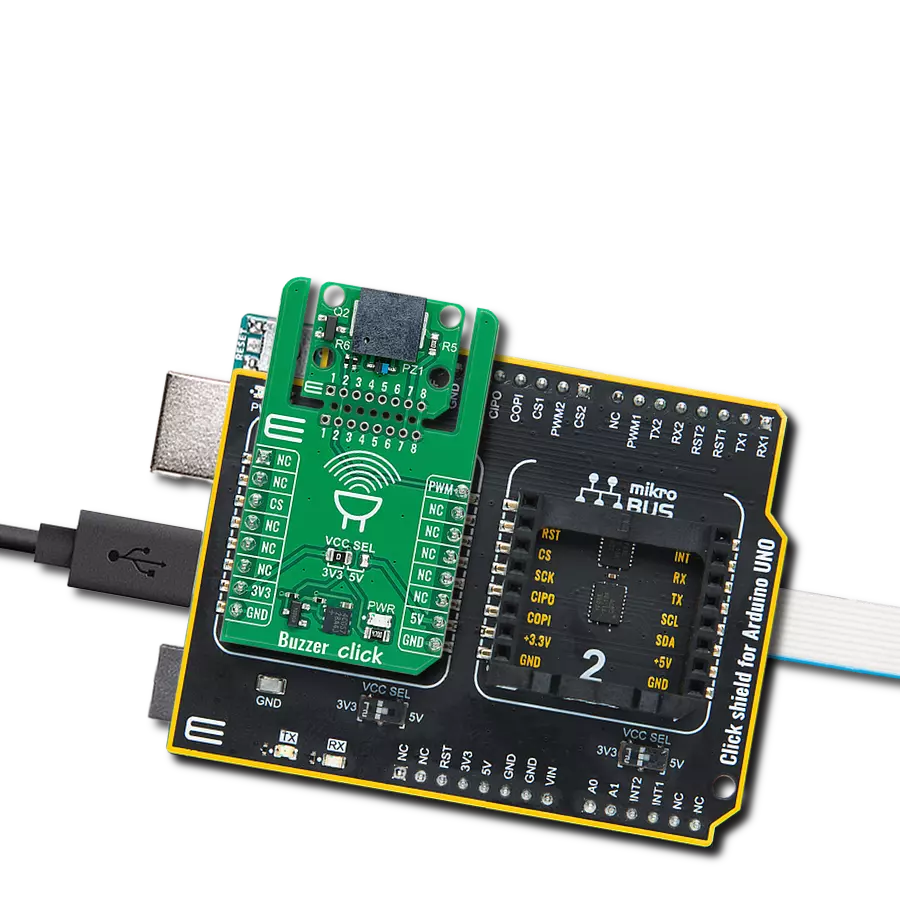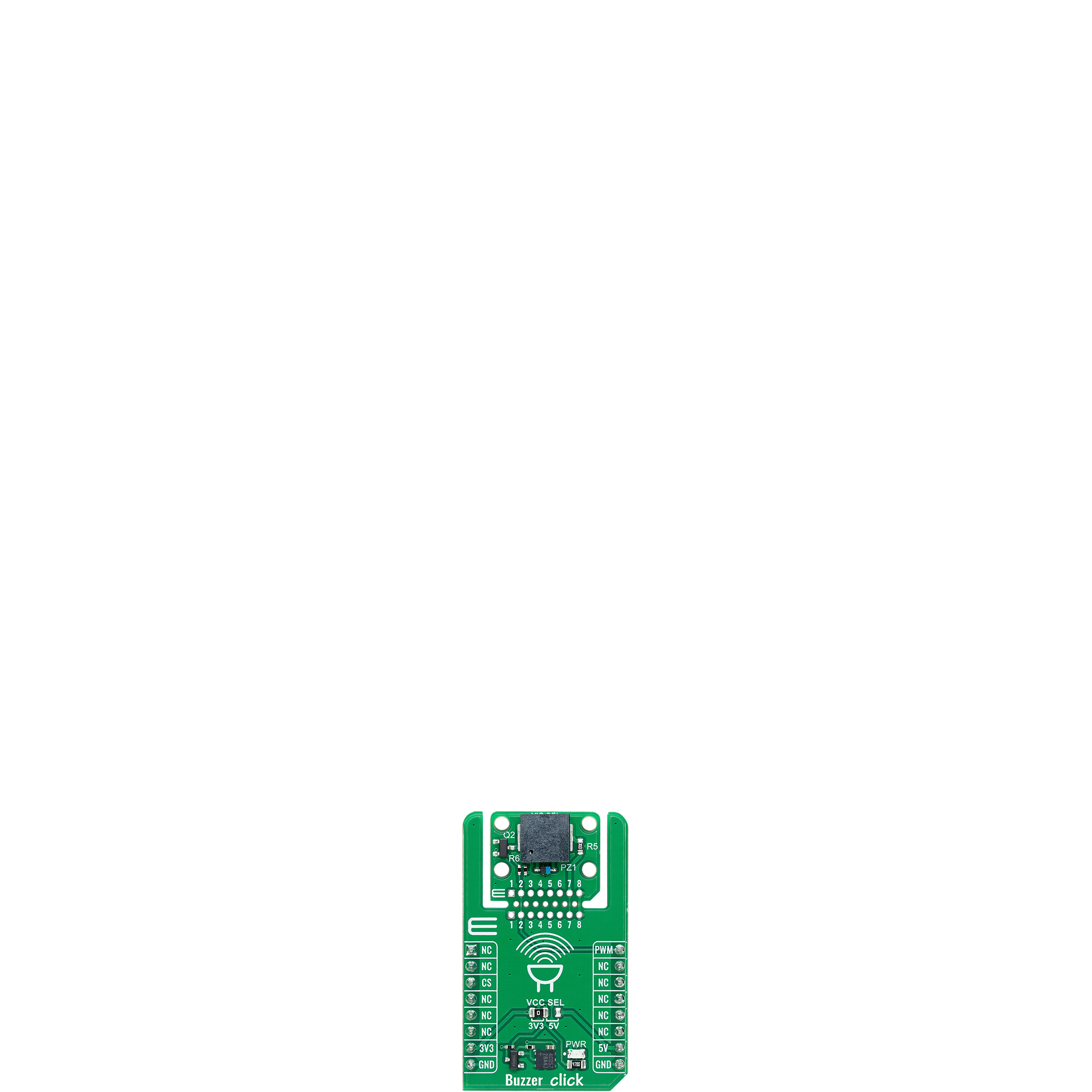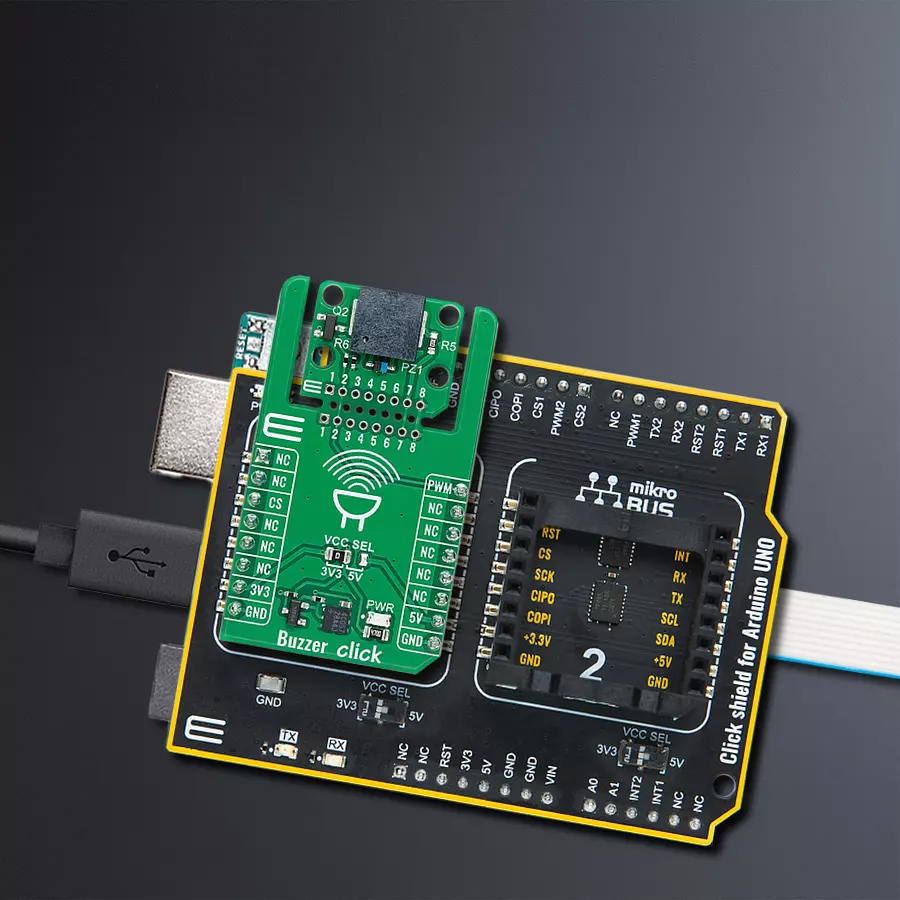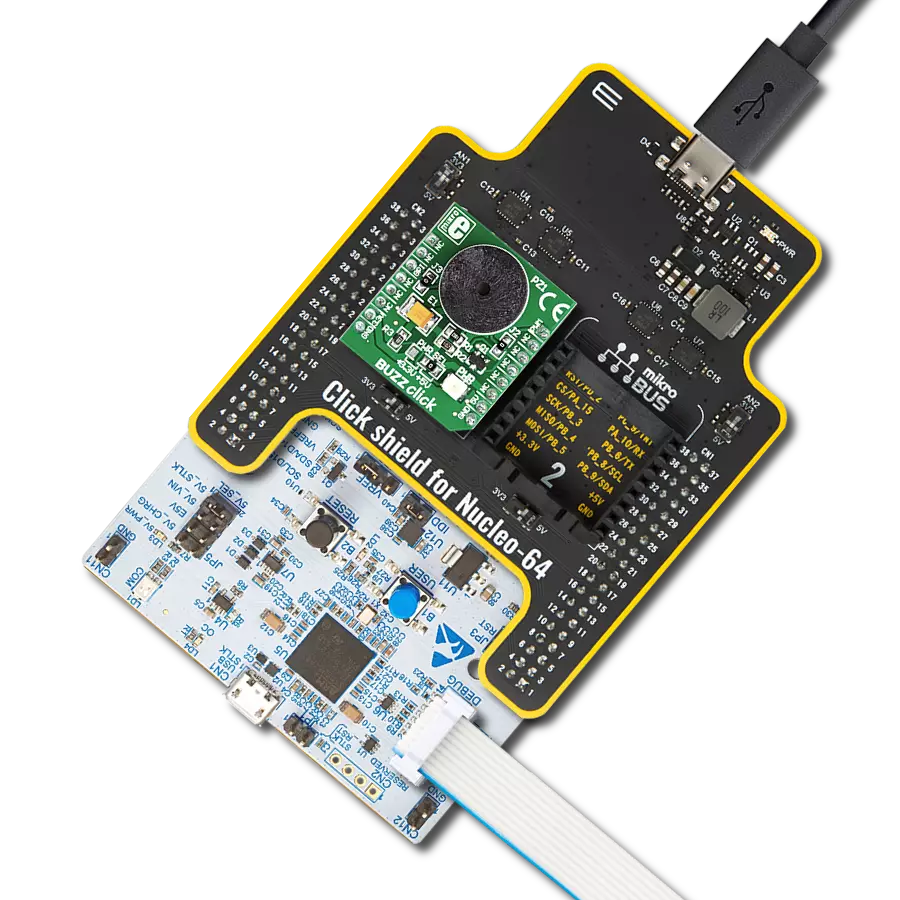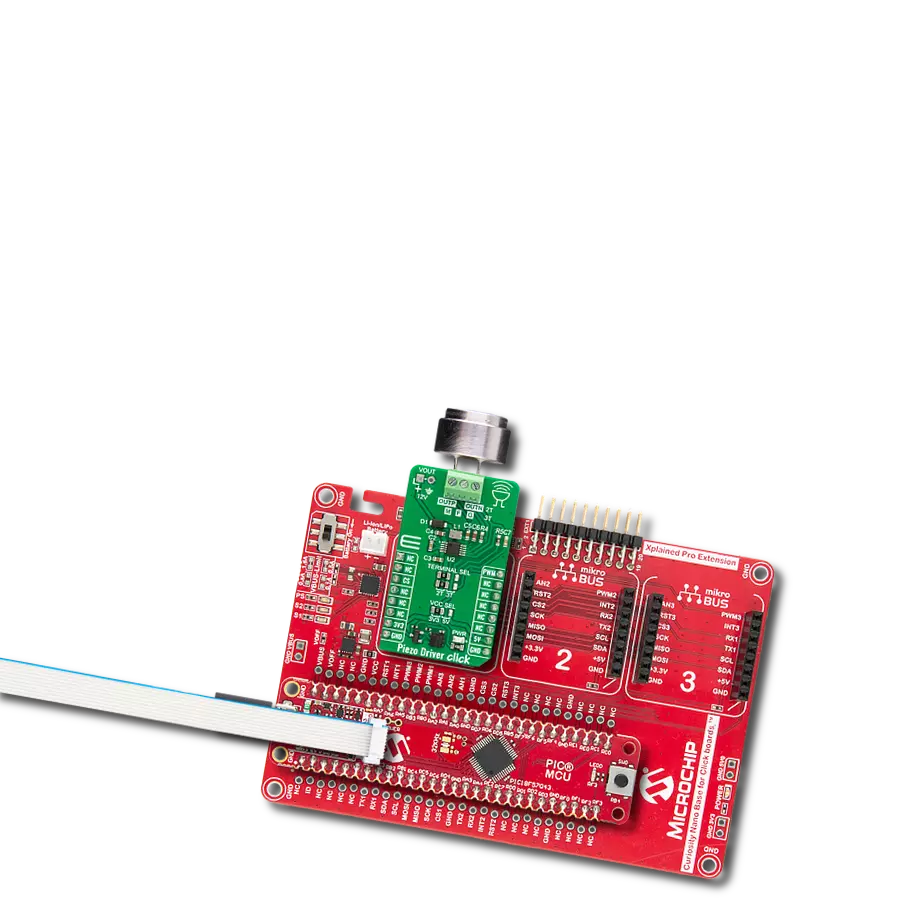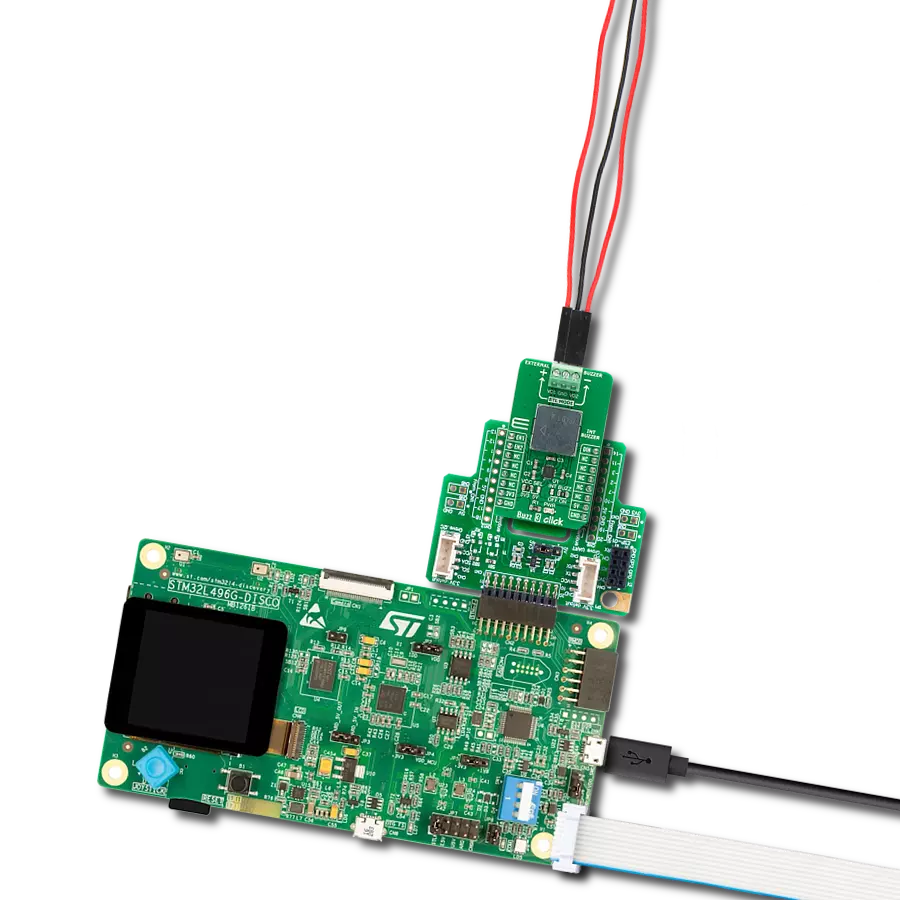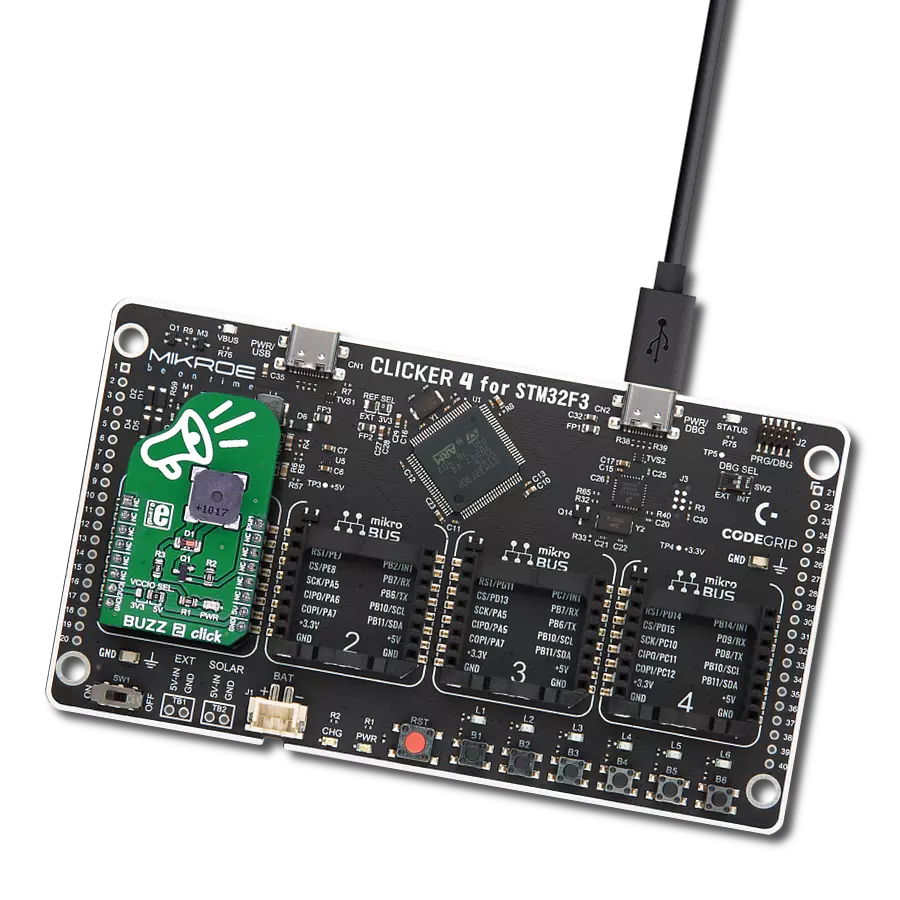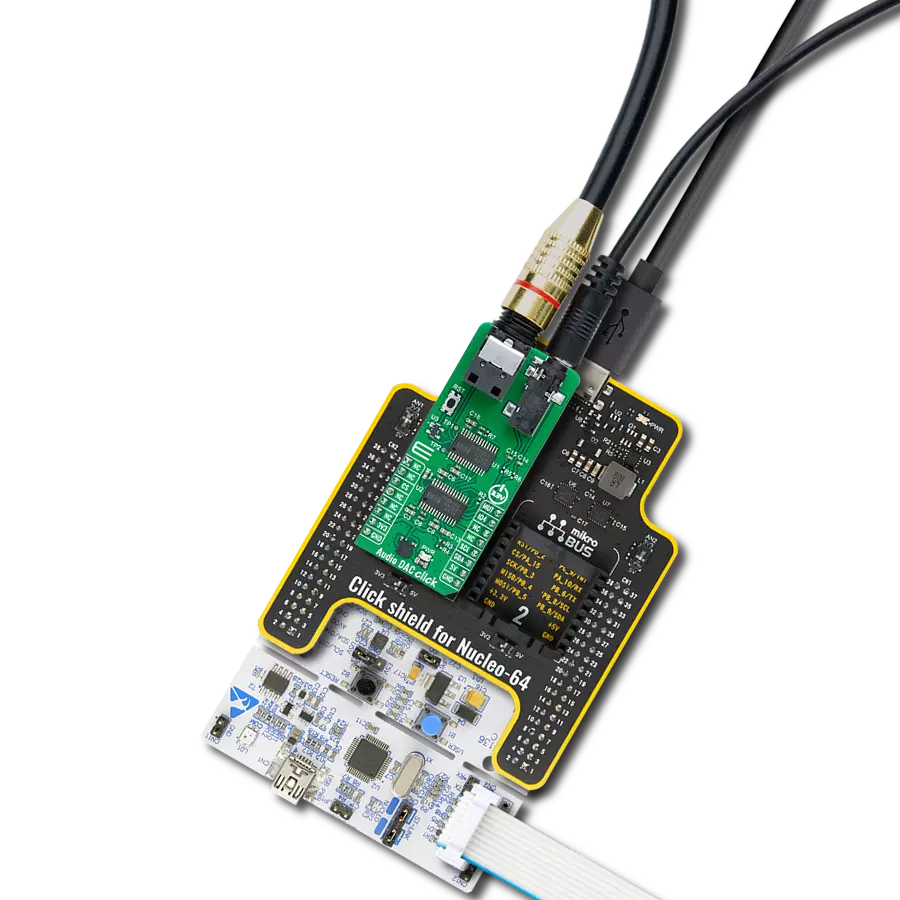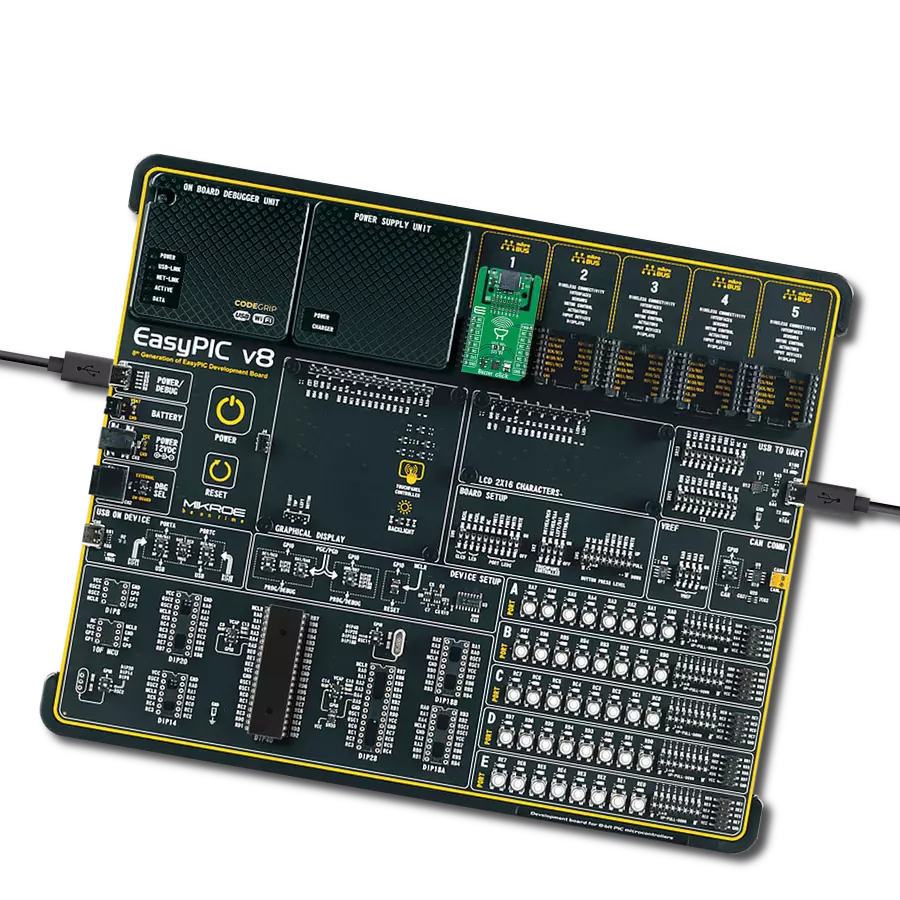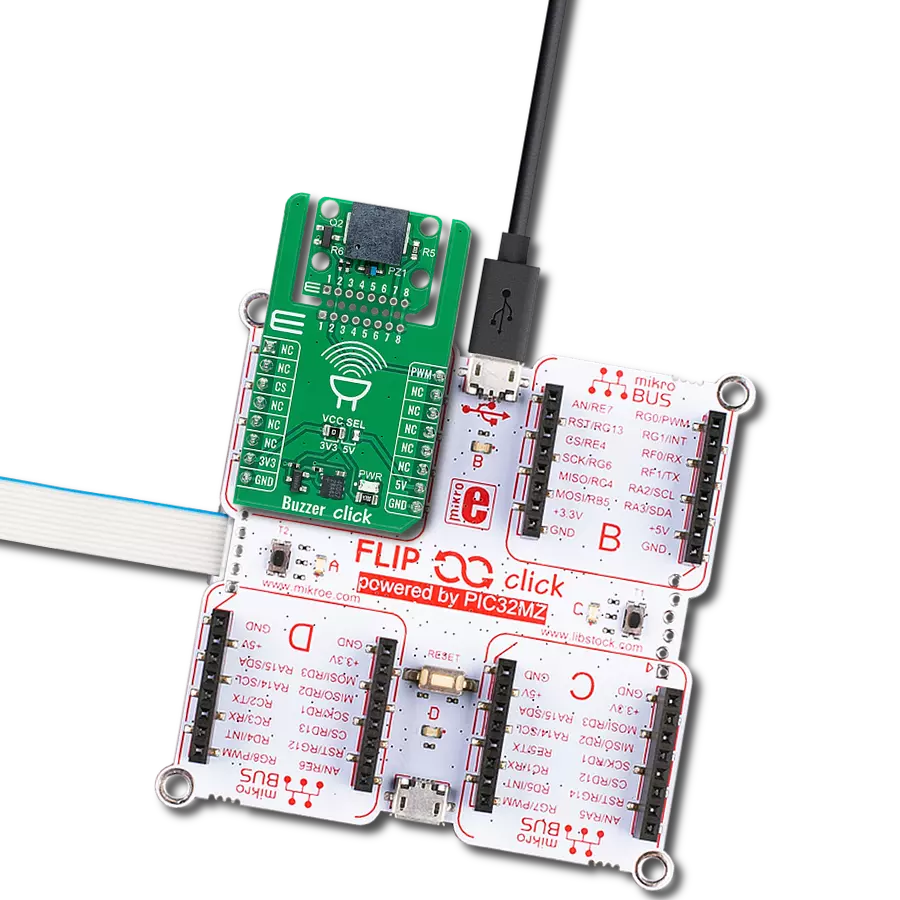Generate audible alerts for security systems or sound signals for notifications or reminders in various projects
A
A
Hardware Overview
How does it work?
Buzzer Click is based on the CPT-7502-65-SMT-TR, a piezoelectric buzzer transducer from CUI Devices designed for efficient and reliable sound output in a surface-mount form factor. The buzzer has a compact square shape with dimensions of 7.5x7.5x2mm and offers a sound pressure level of 65dB, ensuring clear and noticeable sound in various applications. It is externally driven, meaning it requires an external circuit for activation, which is placed on this board. It consumes a low current of only 1mA, making it suitable for battery-powered devices. This Click board™ is designed in a unique format supporting the newly introduced MIKROE feature called "Click
Snap." Unlike the standardized version of Click boards, this feature allows the main sensor area to become movable by breaking the PCB, opening up many new possibilities for implementation. Thanks to the Snap feature, the CPT-7502-65-SMT-TR can operate autonomously by accessing its signals directly on the pins marked 1-8. Additionally, the Snap part includes a specified and fixed screw hole position, enabling users to secure the Snap board in their desired location. This Click board™ uses an N-channel MOSFET to control the buzzer via a PWM signal, allowing for precise modulation of the sound's frequency and intensity. When the PWM signal is applied, the MOSFET enables the flow of
current through the piezoelectric buzzer, activating it and producing sound. This setup provides flexibility in controlling the buzzer's output, making it a versatile solution for sound signaling in various electronic projects. This Click board™ can operate with either 3.3V or 5V logic voltage levels selected via the VCC SEL jumper. This way, both 3.3V and 5V capable MCUs can use the communication lines properly. Also, this Click board™ comes equipped with a library containing easy-to-use functions and an example code that can be used as a reference for further development.
Features overview
Development board
Arduino UNO is a versatile microcontroller board built around the ATmega328P chip. It offers extensive connectivity options for various projects, featuring 14 digital input/output pins, six of which are PWM-capable, along with six analog inputs. Its core components include a 16MHz ceramic resonator, a USB connection, a power jack, an
ICSP header, and a reset button, providing everything necessary to power and program the board. The Uno is ready to go, whether connected to a computer via USB or powered by an AC-to-DC adapter or battery. As the first USB Arduino board, it serves as the benchmark for the Arduino platform, with "Uno" symbolizing its status as the
first in a series. This name choice, meaning "one" in Italian, commemorates the launch of Arduino Software (IDE) 1.0. Initially introduced alongside version 1.0 of the Arduino Software (IDE), the Uno has since become the foundational model for subsequent Arduino releases, embodying the platform's evolution.
Microcontroller Overview
MCU Card / MCU
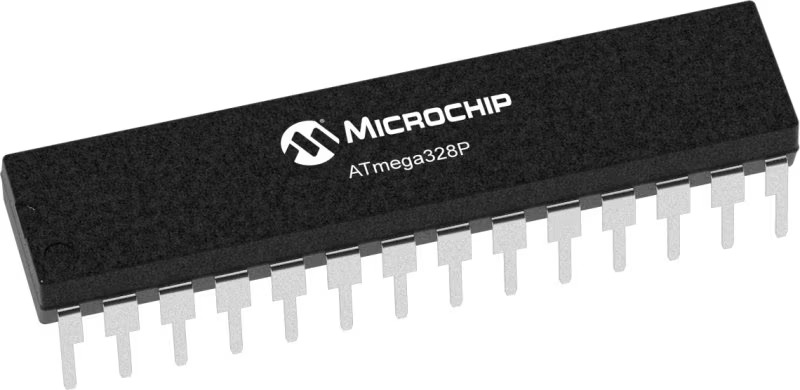
Architecture
AVR
MCU Memory (KB)
32
Silicon Vendor
Microchip
Pin count
28
RAM (Bytes)
2048
You complete me!
Accessories
Click Shield for Arduino UNO has two proprietary mikroBUS™ sockets, allowing all the Click board™ devices to be interfaced with the Arduino UNO board without effort. The Arduino Uno, a microcontroller board based on the ATmega328P, provides an affordable and flexible way for users to try out new concepts and build prototypes with the ATmega328P microcontroller from various combinations of performance, power consumption, and features. The Arduino Uno has 14 digital input/output pins (of which six can be used as PWM outputs), six analog inputs, a 16 MHz ceramic resonator (CSTCE16M0V53-R0), a USB connection, a power jack, an ICSP header, and reset button. Most of the ATmega328P microcontroller pins are brought to the IO pins on the left and right edge of the board, which are then connected to two existing mikroBUS™ sockets. This Click Shield also has several switches that perform functions such as selecting the logic levels of analog signals on mikroBUS™ sockets and selecting logic voltage levels of the mikroBUS™ sockets themselves. Besides, the user is offered the possibility of using any Click board™ with the help of existing bidirectional level-shifting voltage translators, regardless of whether the Click board™ operates at a 3.3V or 5V logic voltage level. Once you connect the Arduino UNO board with our Click Shield for Arduino UNO, you can access hundreds of Click boards™, working with 3.3V or 5V logic voltage levels.
Used MCU Pins
mikroBUS™ mapper
Take a closer look
Click board™ Schematic

Step by step
Project assembly
Track your results in real time
Application Output
1. Application Output - In Debug mode, the 'Application Output' window enables real-time data monitoring, offering direct insight into execution results. Ensure proper data display by configuring the environment correctly using the provided tutorial.

2. UART Terminal - Use the UART Terminal to monitor data transmission via a USB to UART converter, allowing direct communication between the Click board™ and your development system. Configure the baud rate and other serial settings according to your project's requirements to ensure proper functionality. For step-by-step setup instructions, refer to the provided tutorial.

3. Plot Output - The Plot feature offers a powerful way to visualize real-time sensor data, enabling trend analysis, debugging, and comparison of multiple data points. To set it up correctly, follow the provided tutorial, which includes a step-by-step example of using the Plot feature to display Click board™ readings. To use the Plot feature in your code, use the function: plot(*insert_graph_name*, variable_name);. This is a general format, and it is up to the user to replace 'insert_graph_name' with the actual graph name and 'variable_name' with the parameter to be displayed.

Software Support
Library Description
This library contains API for Buzzer Click driver.
Key functions:
buzzer_play_sound- This function plays sound on the buzzer.
Open Source
Code example
The complete application code and a ready-to-use project are available through the NECTO Studio Package Manager for direct installation in the NECTO Studio. The application code can also be found on the MIKROE GitHub account.
/*!
* @file main.c
* @brief Buzzer Click example
*
* # Description
* This example demonstrates the use of Buzzer Click board by playing
* the Imperial March melody on the buzzer.
*
* The demo application is composed of two sections :
*
* ## Application Init
* Initializes the driver and logger.
*
* ## Application Task
* Plays the Imperial March melody. Also logs an appropriate message on the USB UART.
*
* @note
* The minimal PWM Clock frequency required for this example is the frequency of tone C6 - 1047 Hz.
* So, in order to run this example and play all tones correctly, the user will need to decrease
* the MCU's main clock frequency in MCU Settings for the certain architectures
* in order to get the required PWM clock frequency.
*
* @author Stefan Filipovic
*
*/
#include "board.h"
#include "log.h"
#include "buzzer.h"
static buzzer_t buzzer;
static log_t logger;
/**
* @brief Buzzer imperial march function.
* @details This function plays the Imperial March melody on the buzzer
* at the selected volume level.
* @param[in] volume : Buzz sound level. ( min = 1, max = 100 )
* @return None.
* @note None.
*/
static void buzzer_imperial_march ( uint8_t volume );
void application_init ( void )
{
log_cfg_t log_cfg; /**< Logger config object. */
buzzer_cfg_t buzzer_cfg; /**< Click config object. */
/**
* Logger initialization.
* Default baud rate: 115200
* Default log level: LOG_LEVEL_DEBUG
* @note If USB_UART_RX and USB_UART_TX
* are defined as HAL_PIN_NC, you will
* need to define them manually for log to work.
* See @b LOG_MAP_USB_UART macro definition for detailed explanation.
*/
LOG_MAP_USB_UART( log_cfg );
log_init( &logger, &log_cfg );
log_info( &logger, " Application Init " );
// Click initialization.
buzzer_cfg_setup( &buzzer_cfg );
BUZZER_MAP_MIKROBUS( buzzer_cfg, MIKROBUS_1 );
if ( PWM_ERROR == buzzer_init( &buzzer, &buzzer_cfg ) )
{
log_error( &logger, " Communication init." );
for ( ; ; );
}
log_info( &logger, " Application Task " );
}
void application_task ( void )
{
log_printf( &logger, " Playing the Imperial March melody...\r\n" );
buzzer_imperial_march( BUZZER_VOLUME_MAX );
Delay_ms ( 1000 );
Delay_ms ( 1000 );
}
int main ( void )
{
/* Do not remove this line or clock might not be set correctly. */
#ifdef PREINIT_SUPPORTED
preinit();
#endif
application_init( );
for ( ; ; )
{
application_task( );
}
return 0;
}
static void buzzer_imperial_march ( uint8_t volume )
{
buzzer_play_sound( &buzzer, BUZZER_NOTE_A6, volume, BUZZER_NOTE_LEN_QUARTER );
Delay_ms ( BUZZER_NOTE_LEN_QUARTER );
buzzer_play_sound( &buzzer, BUZZER_NOTE_A6, volume, BUZZER_NOTE_LEN_QUARTER );
Delay_ms ( BUZZER_NOTE_LEN_QUARTER );
buzzer_play_sound( &buzzer, BUZZER_NOTE_A6, volume, BUZZER_NOTE_LEN_QUARTER );
Delay_ms ( BUZZER_NOTE_LEN_QUARTER );
buzzer_play_sound( &buzzer, BUZZER_NOTE_F6, volume, BUZZER_NOTE_LEN_EIGHTH + BUZZER_NOTE_LEN_SIXTEENTH );
Delay_ms ( BUZZER_NOTE_LEN_EIGHTH + BUZZER_NOTE_LEN_SIXTEENTH );
buzzer_play_sound( &buzzer, BUZZER_NOTE_C7, volume, BUZZER_NOTE_LEN_SIXTEENTH );
Delay_ms ( BUZZER_NOTE_LEN_SIXTEENTH );
buzzer_play_sound( &buzzer, BUZZER_NOTE_A6, volume, BUZZER_NOTE_LEN_QUARTER );
Delay_ms ( BUZZER_NOTE_LEN_QUARTER );
buzzer_play_sound( &buzzer, BUZZER_NOTE_F6, volume, BUZZER_NOTE_LEN_EIGHTH + BUZZER_NOTE_LEN_SIXTEENTH );
Delay_ms ( BUZZER_NOTE_LEN_EIGHTH + BUZZER_NOTE_LEN_SIXTEENTH );
buzzer_play_sound( &buzzer, BUZZER_NOTE_C7, volume, BUZZER_NOTE_LEN_SIXTEENTH );
Delay_ms ( BUZZER_NOTE_LEN_SIXTEENTH );
buzzer_play_sound( &buzzer, BUZZER_NOTE_A6, volume, BUZZER_NOTE_LEN_HALF );
Delay_ms ( BUZZER_NOTE_LEN_HALF );
buzzer_play_sound( &buzzer, BUZZER_NOTE_E7, volume, BUZZER_NOTE_LEN_QUARTER );
Delay_ms ( BUZZER_NOTE_LEN_QUARTER );
buzzer_play_sound( &buzzer, BUZZER_NOTE_E7, volume, BUZZER_NOTE_LEN_QUARTER );
Delay_ms ( BUZZER_NOTE_LEN_QUARTER );
buzzer_play_sound( &buzzer, BUZZER_NOTE_E7, volume, BUZZER_NOTE_LEN_QUARTER );
Delay_ms ( BUZZER_NOTE_LEN_QUARTER );
buzzer_play_sound( &buzzer, BUZZER_NOTE_F7, volume, BUZZER_NOTE_LEN_EIGHTH + BUZZER_NOTE_LEN_SIXTEENTH );
Delay_ms ( BUZZER_NOTE_LEN_EIGHTH + BUZZER_NOTE_LEN_SIXTEENTH );
buzzer_play_sound( &buzzer, BUZZER_NOTE_C7, volume, BUZZER_NOTE_LEN_SIXTEENTH );
Delay_ms ( BUZZER_NOTE_LEN_SIXTEENTH );
buzzer_play_sound( &buzzer, BUZZER_NOTE_Ab6, volume, BUZZER_NOTE_LEN_QUARTER );
Delay_ms ( BUZZER_NOTE_LEN_QUARTER );
buzzer_play_sound( &buzzer, BUZZER_NOTE_F6, volume, BUZZER_NOTE_LEN_EIGHTH + BUZZER_NOTE_LEN_SIXTEENTH );
Delay_ms ( BUZZER_NOTE_LEN_EIGHTH + BUZZER_NOTE_LEN_SIXTEENTH );
buzzer_play_sound( &buzzer, BUZZER_NOTE_C7, volume, BUZZER_NOTE_LEN_SIXTEENTH );
Delay_ms ( BUZZER_NOTE_LEN_SIXTEENTH );
buzzer_play_sound( &buzzer, BUZZER_NOTE_A6, volume, BUZZER_NOTE_LEN_HALF );
Delay_ms ( BUZZER_NOTE_LEN_HALF );
buzzer_play_sound( &buzzer, BUZZER_NOTE_A7, volume, BUZZER_NOTE_LEN_QUARTER );
Delay_ms ( BUZZER_NOTE_LEN_QUARTER );
buzzer_play_sound( &buzzer, BUZZER_NOTE_A6, volume, BUZZER_NOTE_LEN_EIGHTH + BUZZER_NOTE_LEN_SIXTEENTH );
Delay_ms ( BUZZER_NOTE_LEN_EIGHTH + BUZZER_NOTE_LEN_SIXTEENTH );
buzzer_play_sound( &buzzer, BUZZER_NOTE_A6, volume, BUZZER_NOTE_LEN_SIXTEENTH );
Delay_ms ( BUZZER_NOTE_LEN_SIXTEENTH );
buzzer_play_sound( &buzzer, BUZZER_NOTE_A7, volume, BUZZER_NOTE_LEN_QUARTER );
Delay_ms ( BUZZER_NOTE_LEN_QUARTER );
buzzer_play_sound( &buzzer, BUZZER_NOTE_Ab7, volume, BUZZER_NOTE_LEN_EIGHTH + BUZZER_NOTE_LEN_SIXTEENTH );
Delay_ms ( BUZZER_NOTE_LEN_EIGHTH + BUZZER_NOTE_LEN_SIXTEENTH );
buzzer_play_sound( &buzzer, BUZZER_NOTE_G7, volume, BUZZER_NOTE_LEN_SIXTEENTH );
Delay_ms ( BUZZER_NOTE_LEN_SIXTEENTH );
buzzer_play_sound( &buzzer, BUZZER_NOTE_Gb7, volume, BUZZER_NOTE_LEN_SIXTEENTH );
Delay_ms ( BUZZER_NOTE_LEN_SIXTEENTH );
buzzer_play_sound( &buzzer, BUZZER_NOTE_E7, volume, BUZZER_NOTE_LEN_QUARTER );
Delay_ms ( BUZZER_NOTE_LEN_QUARTER );
buzzer_play_sound( &buzzer, BUZZER_NOTE_F7, volume, BUZZER_NOTE_LEN_EIGHTH );
Delay_ms ( BUZZER_NOTE_LEN_EIGHTH );
Delay_ms ( BUZZER_NOTE_LEN_EIGHTH );
buzzer_play_sound( &buzzer, BUZZER_NOTE_Bb6, volume, BUZZER_NOTE_LEN_EIGHTH );
Delay_ms ( BUZZER_NOTE_LEN_EIGHTH );
buzzer_play_sound( &buzzer, BUZZER_NOTE_Eb7, volume, BUZZER_NOTE_LEN_QUARTER );
Delay_ms ( BUZZER_NOTE_LEN_QUARTER );
buzzer_play_sound( &buzzer, BUZZER_NOTE_D7, volume, BUZZER_NOTE_LEN_EIGHTH + BUZZER_NOTE_LEN_SIXTEENTH );
Delay_ms ( BUZZER_NOTE_LEN_EIGHTH + BUZZER_NOTE_LEN_SIXTEENTH );
buzzer_play_sound( &buzzer, BUZZER_NOTE_Db7, volume, BUZZER_NOTE_LEN_SIXTEENTH );
Delay_ms ( BUZZER_NOTE_LEN_SIXTEENTH );
buzzer_play_sound( &buzzer, BUZZER_NOTE_C7, volume, BUZZER_NOTE_LEN_SIXTEENTH );
Delay_ms ( BUZZER_NOTE_LEN_SIXTEENTH );
buzzer_play_sound( &buzzer, BUZZER_NOTE_B6, volume, BUZZER_NOTE_LEN_SIXTEENTH );
Delay_ms ( BUZZER_NOTE_LEN_SIXTEENTH );
buzzer_play_sound( &buzzer, BUZZER_NOTE_C7, volume, BUZZER_NOTE_LEN_EIGHTH );
Delay_ms ( BUZZER_NOTE_LEN_EIGHTH );
Delay_ms ( BUZZER_NOTE_LEN_EIGHTH );
buzzer_play_sound( &buzzer, BUZZER_NOTE_F6, volume, BUZZER_NOTE_LEN_EIGHTH );
Delay_ms ( BUZZER_NOTE_LEN_EIGHTH );
buzzer_play_sound( &buzzer, BUZZER_NOTE_Ab6, volume, BUZZER_NOTE_LEN_QUARTER );
Delay_ms ( BUZZER_NOTE_LEN_QUARTER );
buzzer_play_sound( &buzzer, BUZZER_NOTE_F6, volume, BUZZER_NOTE_LEN_EIGHTH + BUZZER_NOTE_LEN_SIXTEENTH );
Delay_ms ( BUZZER_NOTE_LEN_EIGHTH + BUZZER_NOTE_LEN_SIXTEENTH );
buzzer_play_sound( &buzzer, BUZZER_NOTE_A6, volume, BUZZER_NOTE_LEN_SIXTEENTH );
Delay_ms ( BUZZER_NOTE_LEN_SIXTEENTH );
buzzer_play_sound( &buzzer, BUZZER_NOTE_C7, volume, BUZZER_NOTE_LEN_QUARTER );
Delay_ms ( BUZZER_NOTE_LEN_QUARTER );
buzzer_play_sound( &buzzer, BUZZER_NOTE_A6, volume, BUZZER_NOTE_LEN_EIGHTH + BUZZER_NOTE_LEN_SIXTEENTH );
Delay_ms ( BUZZER_NOTE_LEN_EIGHTH + BUZZER_NOTE_LEN_SIXTEENTH );
buzzer_play_sound( &buzzer, BUZZER_NOTE_C7, volume, BUZZER_NOTE_LEN_SIXTEENTH );
Delay_ms ( BUZZER_NOTE_LEN_SIXTEENTH );
buzzer_play_sound( &buzzer, BUZZER_NOTE_E7, volume, BUZZER_NOTE_LEN_HALF );
Delay_ms ( BUZZER_NOTE_LEN_HALF );
buzzer_play_sound( &buzzer, BUZZER_NOTE_A7, volume, BUZZER_NOTE_LEN_QUARTER );
Delay_ms ( BUZZER_NOTE_LEN_QUARTER );
buzzer_play_sound( &buzzer, BUZZER_NOTE_A6, volume, BUZZER_NOTE_LEN_EIGHTH + BUZZER_NOTE_LEN_SIXTEENTH );
Delay_ms ( BUZZER_NOTE_LEN_EIGHTH + BUZZER_NOTE_LEN_SIXTEENTH );
buzzer_play_sound( &buzzer, BUZZER_NOTE_A6, volume, BUZZER_NOTE_LEN_SIXTEENTH );
Delay_ms ( BUZZER_NOTE_LEN_SIXTEENTH );
buzzer_play_sound( &buzzer, BUZZER_NOTE_A7, volume, BUZZER_NOTE_LEN_QUARTER );
Delay_ms ( BUZZER_NOTE_LEN_QUARTER );
buzzer_play_sound( &buzzer, BUZZER_NOTE_Ab7, volume, BUZZER_NOTE_LEN_EIGHTH + BUZZER_NOTE_LEN_SIXTEENTH );
Delay_ms ( BUZZER_NOTE_LEN_EIGHTH + BUZZER_NOTE_LEN_SIXTEENTH );
buzzer_play_sound( &buzzer, BUZZER_NOTE_G7, volume, BUZZER_NOTE_LEN_SIXTEENTH );
Delay_ms ( BUZZER_NOTE_LEN_SIXTEENTH );
buzzer_play_sound( &buzzer, BUZZER_NOTE_Gb7, volume, BUZZER_NOTE_LEN_SIXTEENTH );
Delay_ms ( BUZZER_NOTE_LEN_SIXTEENTH );
buzzer_play_sound( &buzzer, BUZZER_NOTE_E7, volume, BUZZER_NOTE_LEN_SIXTEENTH );
Delay_ms ( BUZZER_NOTE_LEN_SIXTEENTH );
buzzer_play_sound( &buzzer, BUZZER_NOTE_F7, volume, BUZZER_NOTE_LEN_EIGHTH );
Delay_ms ( BUZZER_NOTE_LEN_EIGHTH );
Delay_ms ( BUZZER_NOTE_LEN_EIGHTH );
buzzer_play_sound( &buzzer, BUZZER_NOTE_Bb6, volume, BUZZER_NOTE_LEN_EIGHTH );
Delay_ms ( BUZZER_NOTE_LEN_EIGHTH );
buzzer_play_sound( &buzzer, BUZZER_NOTE_Eb7, volume, BUZZER_NOTE_LEN_QUARTER );
Delay_ms ( BUZZER_NOTE_LEN_QUARTER );
buzzer_play_sound( &buzzer, BUZZER_NOTE_D7, volume, BUZZER_NOTE_LEN_EIGHTH + BUZZER_NOTE_LEN_SIXTEENTH );
Delay_ms ( BUZZER_NOTE_LEN_EIGHTH + BUZZER_NOTE_LEN_SIXTEENTH );
buzzer_play_sound( &buzzer, BUZZER_NOTE_Db7, volume, BUZZER_NOTE_LEN_SIXTEENTH );
Delay_ms ( BUZZER_NOTE_LEN_SIXTEENTH );
buzzer_play_sound( &buzzer, BUZZER_NOTE_C7, volume, BUZZER_NOTE_LEN_SIXTEENTH );
Delay_ms ( BUZZER_NOTE_LEN_SIXTEENTH );
buzzer_play_sound( &buzzer, BUZZER_NOTE_B6, volume, BUZZER_NOTE_LEN_SIXTEENTH );
Delay_ms ( BUZZER_NOTE_LEN_SIXTEENTH );
buzzer_play_sound( &buzzer, BUZZER_NOTE_C7, volume, BUZZER_NOTE_LEN_EIGHTH );
Delay_ms ( BUZZER_NOTE_LEN_EIGHTH );
Delay_ms ( BUZZER_NOTE_LEN_EIGHTH );
buzzer_play_sound( &buzzer, BUZZER_NOTE_F6, volume, BUZZER_NOTE_LEN_EIGHTH );
Delay_ms ( BUZZER_NOTE_LEN_EIGHTH );
buzzer_play_sound( &buzzer, BUZZER_NOTE_Ab6, volume, BUZZER_NOTE_LEN_QUARTER );
Delay_ms ( BUZZER_NOTE_LEN_QUARTER );
buzzer_play_sound( &buzzer, BUZZER_NOTE_F6, volume, BUZZER_NOTE_LEN_EIGHTH + BUZZER_NOTE_LEN_SIXTEENTH );
Delay_ms ( BUZZER_NOTE_LEN_EIGHTH + BUZZER_NOTE_LEN_SIXTEENTH );
buzzer_play_sound( &buzzer, BUZZER_NOTE_C7, volume, BUZZER_NOTE_LEN_SIXTEENTH );
Delay_ms ( BUZZER_NOTE_LEN_SIXTEENTH );
buzzer_play_sound( &buzzer, BUZZER_NOTE_A6, volume, BUZZER_NOTE_LEN_QUARTER );
Delay_ms ( BUZZER_NOTE_LEN_QUARTER );
buzzer_play_sound( &buzzer, BUZZER_NOTE_F6, volume, BUZZER_NOTE_LEN_EIGHTH + BUZZER_NOTE_LEN_SIXTEENTH );
Delay_ms ( BUZZER_NOTE_LEN_EIGHTH + BUZZER_NOTE_LEN_SIXTEENTH );
buzzer_play_sound( &buzzer, BUZZER_NOTE_C7, volume, BUZZER_NOTE_LEN_SIXTEENTH );
Delay_ms ( BUZZER_NOTE_LEN_SIXTEENTH );
buzzer_play_sound( &buzzer, BUZZER_NOTE_Ab6, volume, BUZZER_NOTE_LEN_HALF );
Delay_ms ( BUZZER_NOTE_LEN_HALF );
}
// ------------------------------------------------------------------------ END
Additional Support
Resources
Category:Speakers
